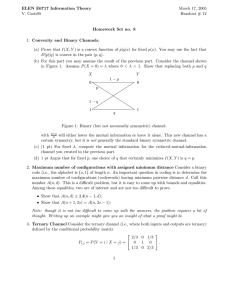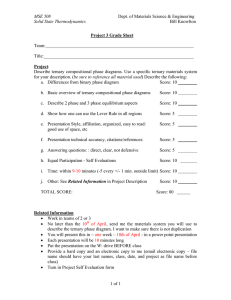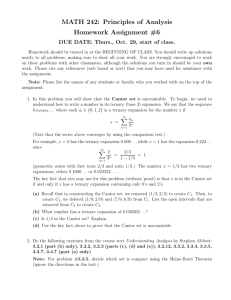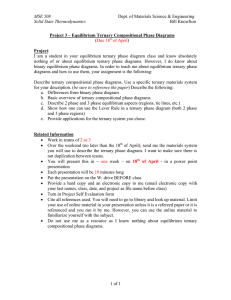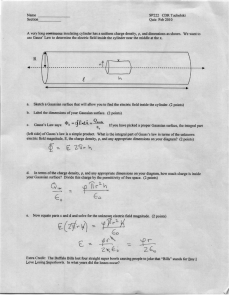9:40 p.m. January 1, 2011 §§ As a preliminary, I explain binary
advertisement
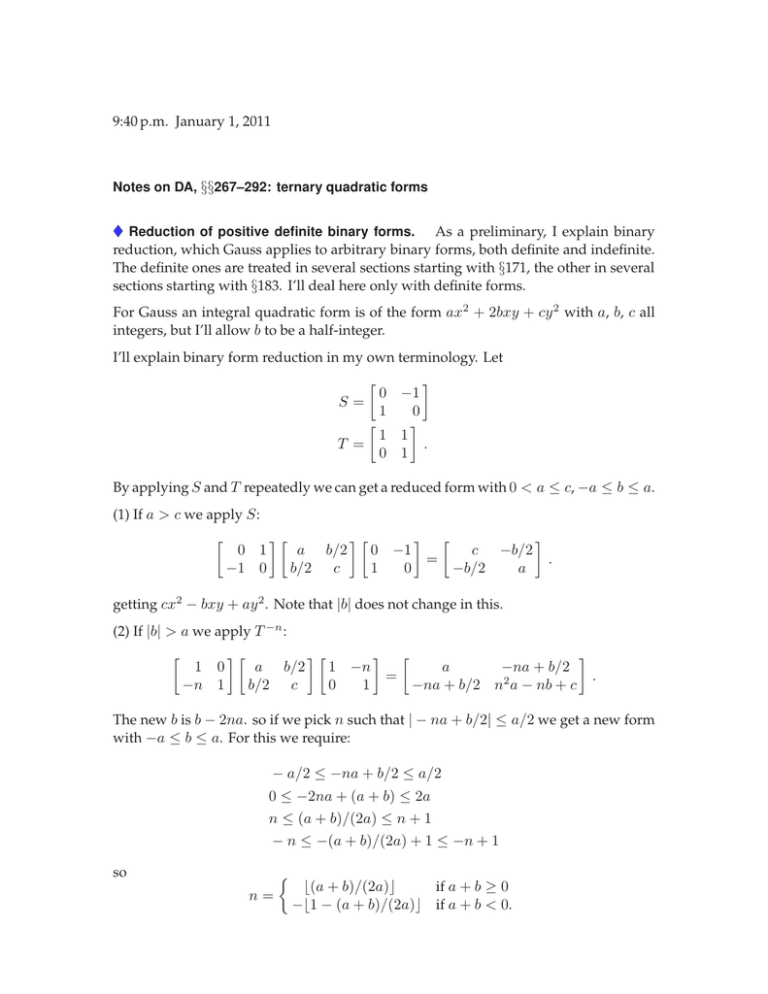
9:40 p.m. January 1, 2011 Notes on DA, §§267–292: ternary quadratic forms Reduction of positive definite binary forms. As a preliminary, I explain binary reduction, which Gauss applies to arbitrary binary forms, both definite and indefinite. The definite ones are treated in several sections starting with §171, the other in several sections starting with §183. I’ll deal here only with definite forms. For Gauss an integral quadratic form is of the form ax2 + 2bxy + cy 2 with a, b, c all integers, but I’ll allow b to be a half-integer. I’ll explain binary form reduction in my own terminology. Let 0 −1 S= 1 0 1 1 T = . 0 1 By applying S and T repeatedly we can get a reduced form with 0 < a ≤ c, −a ≤ b ≤ a. (1) If a > c we apply S : 0 1 −1 0 a b/2 b/2 c 0 −1 c −b/2 = . 1 0 −b/2 a getting cx2 − bxy + ay 2 . Note that |b| does not change in this. (2) If |b| > a we apply T −n : 1 0 −n 1 a b/2 b/2 c 1 −n a −na + b/2 = . 0 1 −na + b/2 n2 a − nb + c The new b is b − 2na. so if we pick n such that | − na + b/2| ≤ a/2 we get a new form with −a ≤ b ≤ a. For this we require: − a/2 ≤ −na + b/2 ≤ a/2 0 ≤ −2na + (a + b) ≤ 2a n ≤ (a + b)/(2a) ≤ n + 1 − n ≤ −(a + b)/(2a) + 1 ≤ −n + 1 so n= ⌊(a + b)/(2a)⌋ if a + b ≥ 0 −⌊1 − (a + b)/(2a)⌋ if a + b < 0. Gauss on ternary forms (9:40 p.m. January 1, 2011) 2 This step does not change a. So at each step, the previous simplification is not erased, and eventually we must get a reduced form. If f is reduced, then 4a2 ≤ 4ac = D + b2 ≤ D + a2 , 3a2 ≤ D, a≤ p D/3 so a is bounded. But then b is bounded—in fact we must have D ≤ D + b2 ≤ D + a2 must be a multiple of 4a—and c = (D + b2 )/4a is determined. So there are only a finite number of reduced positive definite forms with a given discriminant D. Binary forms and the upper half plane. How do positive definite binary forms relate to Möbius transforms on the upper half-plane? The complex number z corresponds to the lattice spanned by 1 and z , with quadratic form (m + nz)(m + z) = m2 + 2mn RE (z) + n2 |z|2 . These are all the real positive definite forms ax2 + bxy + cy 2 with a = 1. If we start with an arbitrary form ax2 + bxy + cy 2 we can simply scale it to x2 + (b/a)xy + (c/a)y 2, and then map it to p + qi with 2p = (b/a) p2 + q 2 = (c/a) p q = (c/a) − (b/2a)2 √ 4ac − b2 = , 2a which is OK since the determinant ac−b2 /4 is positive. So the reduction process agrees with the fact that |z| ≥ 1, |RE(z)| ≤ 1/2 is a fundamental domain for SL2 (Z) acting on H. Genera. Two forms are said to be in the same genus if the are equivalent modulo all pn . If p does not divide the discriminant, then the discriminant alone determines the equivalence modulo p, then by Hensel’s Lemma modulo all pn . So we just have to figure out what happens for p dividing D. And in fact probably modulo pk if pk is the p-factor of D, presumably by the singular form of Hensel’s Lemma? Cassel tells us how to decide: if p is odd all forms over Zp are sums of pn Qi where Qi one of the two canonical forms over Z/p—a sum of hyperbolic planes plus zilch, x2 , ax2 with a/p = −1, or the norm of a quadratic extension. (This by Minkowski.) If p = 2, we get a sum of 2k times x2 , 3x2 , 5x2 , 7x2 , xy , or x2 + xy + y 2 . Outline of Gauss. §§262–270: Introduction to ternary forms Gauss on ternary forms (9:40 p.m. January 1, 2011) 3 §§271–277: Reduction §§278–292: Representations of numbers and binary forms by ternary forms 266. Basic idea. As for binary forms, his forms correspond to integral matrices. 267. Terminology and adjoint forms (in my own terminology). If a linear transfor- mation T has matrix m1,1 m1,2 M = m2,1 m2,2 m3,1 m3,2 m1,3 m2,3 m3,3 with respect to basis ei then its adjoint is the matrix of the transformation ∧2 T with respect to the (properly oriented) dual basis e2 ∧ e3 , e3 ∧ e1 , e1 ∧ e2 m2,2 m3,3 − m3,2 m2,3 . . . m3,2 m1,3 − m1,2 m3,3 m1,2 m2,3 − m2,2 m1,3 . Why this choice of basis? Given V of dimension n and a form ω in ∧n V , ∧k V and ∧n−k are dual: u ∧ v = hu, viω . We also have (∧i T u) ∧ (∧j T v) = ∧i+j (u ∧ v) and the fact that M times the transposed adjoint of M is equal to det(M ) · I is just a transliteration of ∧k T ∧n−k T = ∧n T = det(T ) · I . The product in this case represents the equation ∧ T ei ∧ T e∧ j = det(T )(ei ∧ ej ) . (I. e./ a matrix represents all kinds of things, here a bilinear pairing). Transposed adjoint because T ei is rendered as a row vector in a matrix multiplication. What Gauss says is that the form a b′′ f = b′′ a′ b′ b b′ b a′′ has as adjoint the form A B ′′ B ′ b2 − a′ a′′ a′′ b′′ − bb′ a′ b′ − bb′′ F = a′′ b′′ − bb′ b′ b′ − aa′′ ab − b′ b′′ = B ′′ A′ B . B ′ B A′′ a′ b′ − bb′′ ab − b′ b′′ b′′ b′′ − aa′ Gauss on ternary forms (9:40 p.m. January 1, 2011) 4 Gauss’ matrix gives a symmetric bilinear form B(x, y) with Q(x) = B(x, x). This is an isomorphism from Z3 to Z3 , presumably the matrix of the form. It takes u to the linear function T (u) defined by hT (u), vi = B(u, v), hT (ei ), ej i = B(ei , ej ) , so T (ei ) has its expression in the dual basis fi equal to the column of the matrix. It induces another bilinear form on ∧2 Z3 . Is it Gauss’? T (e2 ∧ e3 ) = (b′′ f1 + a′ f2 + bf3 ) ∧ (b′ f1 + bf2 + a′′ f3 ) = (f2 ∧ f3 )(a′ a′′ − bb) + (f3 ∧ f1 )(bb′ − a′′ b′′ ) + (f1 ∧ f2 )(b′′ b − a′ b′ ) T (e3 ∧ e1 ) = (af1 + b′′ f2 + b′ f3 ) ∧ (b′ f1 + bf2 + a′′ f3 ) = (f2 ∧ f3 )(bb′ − b′′ a′′ ) + (f3 ∧ f1 )(aa′′ − b′ b′ ) + (f1 ∧ f2 )(b′ b′′ − ab) T (e1 ∧ e2 ) = (af1 + b′′ f2 + b′ f3 ) ∧ (b′′ f1 + a′ f2 + bf3 ) = (f2 ∧ f3 )(b′′ b − b′ a′ ) + (f3 ∧ f1 )(b′ b′′ − ab) + (f1 ∧ f2 )(aa′ − b′′ b′′ ) with matrix A B ′′ B ′ − B ′′ A′ B = −F . B ′ B A′′ The adjoint of the adjoint is f D, where D is det f . His D is the negative determinant. 268. Substitute α x x′ = α ′ α′′ x′′ β β′ β ′′ y γ ′ ′ . y γ ′′ ′′ y γ We get a new form t xQx = ty tSQSy There is no distinction between equivalence and proper equivalence, since −I is in the orthogonal group. Effect of transforms on adjoints. He calls transforms transpositions. 269. Equivalent if transforms of each other. Two forms are equivalent if and only if their adjoints are equivalent. 270. Composite of transforms by matrix multiplication. 271. Leading to Theorem that there are only a finite number of ternary classes with a given determinant (which will be proved in §276). Criteria for definite forms, positive ones, negative ones. Gauss on ternary forms (9:40 p.m. January 1, 2011) 5 272. Still leading to reduction. The basic idea is to transform f to g by some S , with g simpler in some sense. Look at adjoints F , G, transformed by adjoint of S (§269). I. First we apply the reduction process for binary forms to a b′′ b′′ a′ . by taking α S = α′ 0 √ 3 0 0 . 1 β β′ 0 This gives us |a| ≤ (4/3) D. II. Next take S of the form 0 γ′ . γ ′′ 1 0 S = 0′ β ′ 0 β ′′ and apply the binary reduction to A′′ B B A′ . √ 3 This gives us |A′′ | ≤ (4/3) D2 . III. If neither of these reductions can be applied, . . . we must therefore have |a| ≤ √ √ 3 (4/3) 3 D and |A′′ | ≤ (4/3) D2 . IV. Apply these alternately. Any ternary form of determinant D may be reduced to an equivalent form with the √ √ 3 3 ′′ property that |a| ≤ (4/3) D and |A | ≤ (4/3) D2 . 273. An example: 19 1 28 . f = 121 15 28 15 50 Another example: 10 4 0 . f = 426 7 0 7 2 Gauss on ternary forms (9:40 p.m. January 1, 2011) 6 274. After these, a further reduction can be made by applying 1 β γ S = 0 1 γ′ . 0 0 1 275. The previous examples continued. Theorem. The number of classes into which all ternary forms of a given 276. determinant are distributed is always finite. 277. 278. We now have the following problems: I. To find all representations of a given number by a given ternary form. II. To find all representations of a given binary form by a given ternary form. III. To judge whether or not two given ternary forms are equivalent, and if they are to find all transformations taking one to the other. IV. To find whether or not a given ternary form implies another, and if it does to find all transformations of the first into the second. In this book he will not be complete, but reduce I to II, reduce II to III, give some simple examples, and not discuss IV at all. 279. Lemma. Given any three integers a, a′ , a′′ (not all 0) how to find six others B , B ′ , B ′′ , C , C ′ , C ′′ such that B ′ C ′′ − B ′′ C ′ = a, B ′′ C = BC ′′ = a′ , BC ′ − B ′ C = a”” ? To find all representations of M > 0 by x2 + y 2 + z 2 = M , or −M by −x − y − z 2 = f . 291. 2 2 subsecI First find all binary forms of determinant −M represented by X 2 + Y 2 + Z 2 . When M ≡ 0, 4, or 7 modulo 8 there are none, and M cannot be expressed as a sum of three mutually prime squares.
